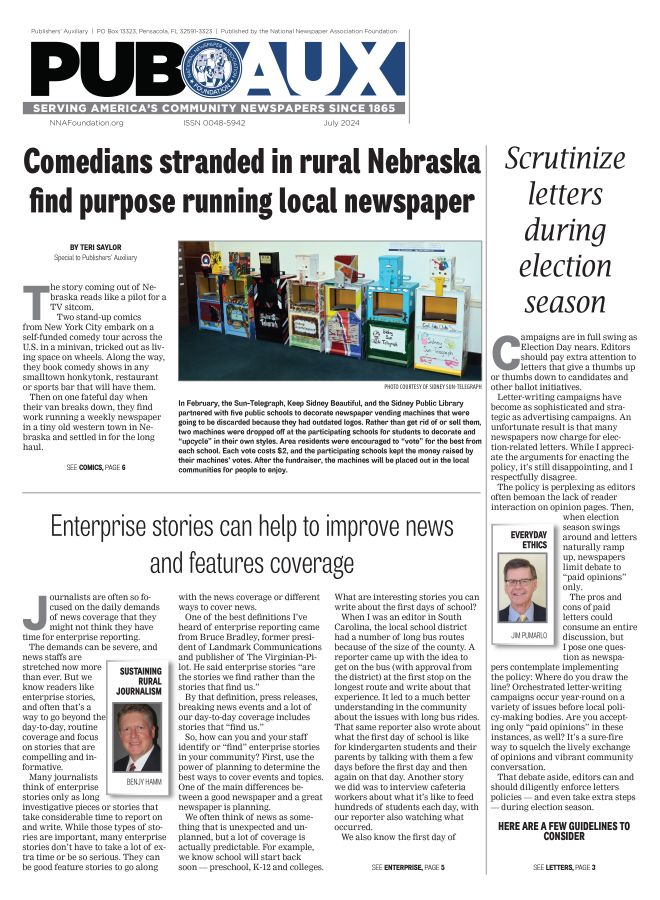Vermont weeklies come back stronger after flood
Apr 3, 2012
WOODSTOCK, VT—Last August when Hurricane Irene swept up the East Coast, weather watchers thought its intensity would diminish as it moved back out into the Atlantic Ocean before it reached New England.
But that’s not exactly what happened. Even though Irene had been downgraded to a tropical storm by the time it hit New England, in Vermont, several towns were caught off guard after 12 inches of rain pounded down into their steep valleys, forcing swollen rivers to jump their banks and overwhelm local storm sewers.
Phil Camp, owner and publisher of The Vermont Standard, was alerted to the quickly rising Ottauquechee River. Most of the advertising in the coming week’s huge 60-page issue along with the fall visitor’s guide had been composed and sent to proofreaders. When Camp arrived at his paper’s office on that Sunday morning, he witnessed how fast the water was rising. He could not save the newspaper’s equipment, barely getting out of the path of floodwaters in time. He estimated 5.5 feet to 6 feet of water swept through the building.
The water receded nearly as quickly as it rose, but the damage had been done. Camp said the force of the water blew out the sides of the building and buried his computers in 1.5 feet of sludge. It was total destruction. The only things not touched were high-hanging photos. To make matters worse, because the office sits in a flood plain, his insurance would only cover $55,000 of the damage.
“I lost $400,000 in the flood,” Camp said. And for a small operation, such a loss could have been fatal. Not for Camp and his people.
He said he could not be prouder of the way his staff rose up in the face of such destruction, working diligently to get the next issue out the door.
“This paper is 159 years old, and it has never missed a week of publishing in its history,” said Camp, who has owned the paper for the last 31 years. “And it was not going to happen on my watch.”
Response from the people in Woodstock was tremendous, he said. People who could afford butlers and maids rolled up their sleeves and worked alongside blue-collar workers, digging out his office equipment.
“Jean Maynes, my business manager, took charge of getting our computer data recovered by getting it to a place to have the damaged units worked on,” he said. The computer repair guy worked 38 hours straight and was able to save 90 percent of the data on the machines. Maynes also bought new Macs and had the data transferred to them. With the information restored, the staff was able to get that 60-page paper with a 56-page insert out only 2.5 days after the paper’s normal publication day.
A fire in 1867 and an earlier flood in 1973 failed to shut The Vermont Standard, and this flood wasn’t going to either. The ’73 flood did destroy the paper’s press. Its printing has been outsourced since then.
Camp said when he heard the reports of the approaching storm he thought he had made all the right preparations. He bought power generators and extra gasoline, knowing the office would most likely lose power.
If he had to, he could hand-carry the paper to the printer. But what was supposed to be a minor wind event turned into a major rain event. Camp said he contacted a local landlord and was offered space in a building on the west, un-flooded side of town.
While the staff worked at the paper to get out the next issue, the Vermont Standard’s webmaster, located in New Hampshire, kept the information flowing to readers.
According to a report General Manager Jon Estey put together for a disaster preparedness presentation to the Tuck School of Business at Dartmouth, Camp’s editor, the paper’s freelance reporters and the 20 village and town correspondents continued to send in reports and photos.
“People learned we were the place to find out what bridges were out and what roads were closed,” Camp said. “If we didn’t know the answer to a question, we would find the answer or direct them to someone who did know the answer. Normally, the website receives about 9,000 unique views a week. During the storm and its aftermath, the count jumped to 150,000 unique views.
“I’ve got to tell you that this proves newspapers are still alive and well.”
That first issue after the storm was devoured by the people in the communities served by the Vermont Standard.
Advertising stayed strong in the paper despite the number of regular advertisers that could not open for business until months after the disaster.
“One guy who has never advertised before came in to buy ads,” Camp said. He added that he was overwhelmed by the outpouring of help from the people of Woodstock.
HIGH, BUT NOT QUITE DRY
In West Dover, VT, the Deerfield Valley News fared much better because its office sits about five miles outside of the town’s center. Even so, owner Randy Capitani, said the tremendous flooding took the town by surprise.
The north branch of the Deerfield River overflowed its banks and hit the town of Wilmington hard.
He estimates 6 feet to 8 feet of water swept through the center of town, putting 100 percent of those businesses out of operation.
“We were worried about advertising,” he said. This was the end of August, a prime tourist time for the area. He had to start thinking about staff cutbacks, doing what he could to keep the paper afloat until local businesses were back on their feet. In addition to the destruction, the tourist area took a double hit with the loss of the fall foliage season and the ski season. Snowfall was below normal, so while the ski resorts could generate snow, the cross country skiers and snowmobile people were left with little or no snow.
“Some of (the downtown businesses) just opened within the last month,” he said.
His third quarter revenue took a hit, but his fourth quarter was as good as the previous year’s revenue.
Like The Vermont Standard, The Deerfield Valley News’ website became the local source of information on which roads were open. He has had an active website since 1995. The site, he said is paying for itself.
In the first issue after the storm, Capitani said he had little advertising but tons of news. He made the extra effort of putting that issue on 35-pound newsprint with as many color photos as he could fit.
He has owned the paper for the past 21 years. For the last seven years, his wife has been his partner in the business.
“We lost businesses, friends and customers” because of the flooding, he said. But they never lost hope.
So far we’ve had a good year, he said. “I feel it’s going to grow. I’m feeling optimistic. I’m looking forward to the summer season.”
©stan@nna.org







